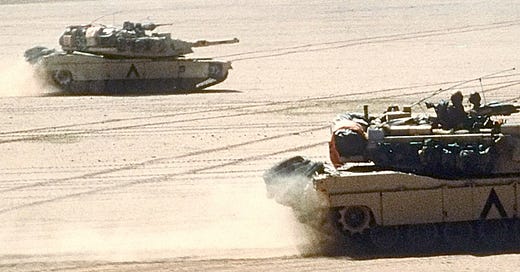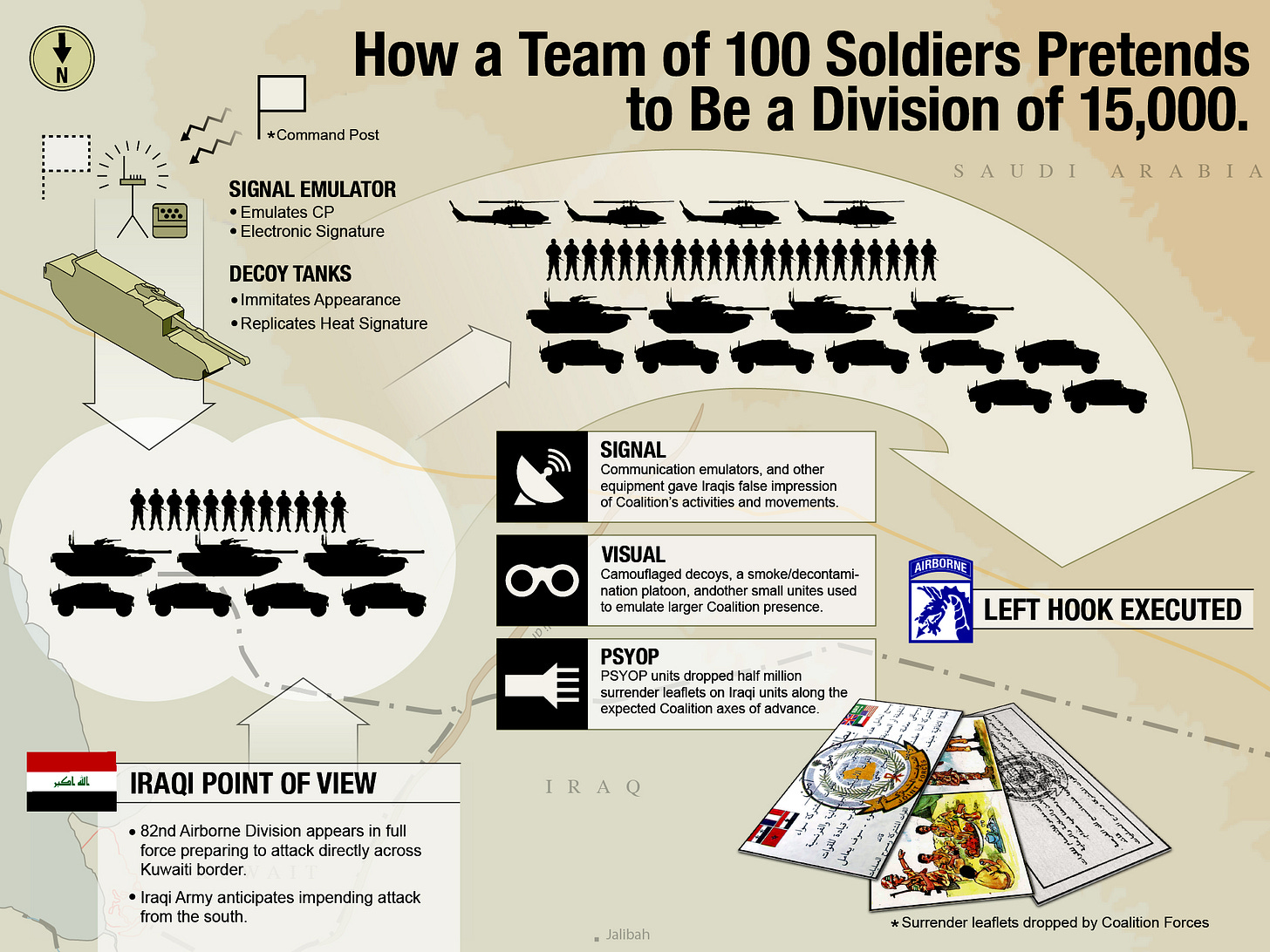Deception in Military Strategic Contexts: Case Analysis
Cases: The Doolittle Raid, Iraq's Denial and Deception Practices with WMDs, Operation Desert Storm and The Bougainville Campaign

Deception is a fundamental aspect of military strategy and it has been instrumental throughout history in shaping the outcomes of conflicts by manipulating the enemy's perceptions and decisions. This case study based article draws extensively from various authoritative sources1, including historical records and contemporary military doctrines, to explore the depth and breadth of deception in warfare.

Foundations of Military Deception
Deception has been a pivotal element of warfare throughout human history, often serving as the cornerstone of both tactical maneuvers and strategic campaigns. This technique, which involves the deliberate dissemination of false information, the creation of misleading appearances, and the orchestration of actions to mislead an adversary, is designed to influence the perception and behavior of opponents, thus securing a tactical or strategic advantage. From the earliest recorded conflicts, the use of deception can be traced back to seminal military texts and historical battles. One of the oldest military treatises, Sun Tzu's The Art of War, explicitly states, "All warfare is based on deception."2 This principle underscores the importance of misleading the enemy regarding one's capabilities, intentions, and movements. Sun Tzu advocated for strategies such as feigning incapacity until the enemy exposes his vulnerabilities, thereby ensuring that the element of surprise could be maintained and leveraged. A classic example from antiquity that embodies the use of strategic deception is the story of the Trojan Horse. During the Trojan War, the Greeks, unable to breach the fortified city of Troy, resorted to subterfuge. They constructed a large wooden horse in which soldiers hid, while the rest of the Greek forces pretended to retreat. The Trojans, believing the horse to be a parting gift and a symbol of their victory, brought it inside the city walls. By night, the Greek soldiers emerged from the horse, opened the gates for their compatriots, and initiated the sack of Troy. This tale, whether myth or reality, illustrates the potential of deception to alter the course of conflicts dramatically. The strategic use of deception reached new heights during World War II, showcasing its effectiveness in large-scale operations. One of the most notable instances was the D-Day landings, where the Allies executed Operation Bodyguard. This operation involved an extensive campaign of misinformation, including the use of double agents and fake equipment, to convince the Nazis that the invasion would occur at Pas de Calais instead of Normandy. The success of the landings was significantly aided by the Germans' diverted attentions and resources. Similarly, Admiral William F. Halsey utilized deception during the Pacific War against Japan. Known for his aggressive tactics, Halsey was involved in several operations where deceptive maneuvers played critical roles, during the Bougainville campaign and other operations, he effectively used misinformation3 and tactical feints to mislead Japanese forces about the strength and positions of American naval forces.
Framework of Deception (R.V. Jones) and Contemporary Military Doctrines
Reginald Victor Jones4, a key figure in British intelligence during World War II, was instrumental in formulating and applying principles of security and deception, which he outlined in his works on military strategy. His contributions are particularly significant for the development of methodologies around dissimulation, concealing the real and simulation displaying the false. These techniques are foundational in crafting illusions that manipulate enemy perceptions across various dimensions such as the location, strength, and intentions of military forces. Jones's strategic insights emphasized the importance of misleading the enemy about a wide range of tactical and strategic metrics. Deceiving the enemy about one's location, the nature of one's forces, and intended actions. This kind of strategic deception was critical in operations such as the misleading of German forces about the D-Day invasion plans, where the Allies successfully convinced the Germans that they would land at Pas de Calais instead of Normandy. This operation not only exemplifies the use of simulation creating a false impression about the landing site but also dissimulation, as it involved hiding the real landing plans. Modern military doctrines have expanded on the foundations laid by theorists like R.V. Jones, integrating advanced technologies and methodologies to enhance the scope and efficacy of deception. The U.S. Department of Defense actively incorporates deception across multiple platforms5, embracing cyber operations and psychological warfare to create comprehensive strategies for misleading adversaries strategically. This approach is reflected in contemporary military training programs and operational guidelines, emphasizing the continuous evolution of deception tactics from merely physical misdirections to complex, multi-dimensional strategies involving digital warfare and media manipulation
Case Studies: Deception
1. The Doolittle Raid and Admiral Halsey’s Deception Tactics
Admiral William F. Halsey played a pivotal role in the Pacific Theater during World War II. Known for his aggressive tactics and strategic acumen, Halsey's use of deception was crucial in several operations, including the Doolittle Raid. In the lead-up to the Doolittle Raid on Tokyo in 1942, Halsey utilized a series of deceptive maneuvers to mislead Japanese intelligence regarding the whereabouts and intentions of the U.S. fleet. By strategically broadcasting false radio messages and deploying naval forces in misleading patterns, Halsey helped ensure the Japanese were unprepared for the raid, which was the first air attack on the Japanese home islands. This operation boosted American morale and demonstrated the vulnerability of Japanese territory to air attacks, despite it achieving minimal strategic damage.
2. Iraq's Denial and Deception Practices with WMDs
The case of Iraq's Weapons of Mass Destruction (WMD) programs is a seminal example of the use of denial and deception in modern conflict. David A. Kay, as the head of the Iraq Survey Group, conducted detailed investigations into the extent and nature of Iraq's WMD capabilities. The findings and experiences from these investigations offer a clear view of how Iraq employed deception techniques to mask the true state of its WMD arsenal. One of the key strategies used by Iraq to deceive international inspectors and intelligence agencies was the construction of extensive underground facilities. These facilities were designed to be difficult to detect and were often embedded deep beneath civilian structures or in remote areas, complicating surveillance and reconnaissance efforts. The complexity and secrecy surrounding these installations contributed to the uncertainty regarding the scale and readiness of Iraq's WMD capabilities. Iraq also utilized mobile production units for chemical and biological weapons. These units could be easily relocated and were often disguised as civilian trucks or placed within legitimate manufacturing settings, making them nearly impossible to track consistently. This mobility allowed Iraq to evade inspection protocols that were designed for static sites, thereby maintaining a facade of compliance with international regulations while continuing to develop and potentially deploy WMDs. The Iraqi regime orchestrated systematic misinformation campaigns to further obscure the state of its WMD programs. This involved leaking false or misleading information to foreign intelligence services and international bodies6, as well as public statements by Iraqi officials that contradicted findings from independent assessments. These campaigns were aimed at creating a narrative of compliance and disarmament, which was intended to alleviate international pressure and scrutiny.
3. Operation Desert Storm and the British Doctrine of Deception
During the 1991 Gulf War, Operation Desert Storm was a pivotal campaign where the Coalition forces led by the United States executed a large-scale offensive against Iraqi forces. The operation was marked by a highly sophisticated deception strategy that played a crucial role in the overwhelming victory. The Coalition's deception plan, known as "Operation Fortitude South,"7 was designed to mislead Iraqi forces about the timing and location of the main Coalition ground attack. This involved the construction of fake oil pipelines and extensive simulations of amphibious assault operations in the Persian Gulf. These simulations were supported by the deployment of dummy equipment and broadcasting of fictitious radio traffic. The objective was to fix Iraqi attention on the coastal areas, convincing them that a seaside invasion was imminent. The deceptive maneuvers succeeded in diluting Iraqi defensive efforts across the Kuwaiti theater of operations. When the ground campaign commenced, Iraqi forces were unprepared for the actual scale and direction of the ground assault, leading to rapid Coalition victories. The effective use of deception not only facilitated a swift ground offensive but also minimized Coalition casualties and maximized the operational surprise. The British military has a long tradition of stratagem and deception, influencing various countries' military doctrines, including those of the United States, Israel, India, and Pakistan. The British doctrine of deception8, refined during both World Wars, focuses on misleading the enemy about military capabilities, intentions, and operations. This has been incorporated into modern training programs and operational strategies in the aforementioned countries, adapting to new technological and geopolitical realities. During the Gulf War, Coalition forces led by the United States implemented deception tactics that mirrored those refined by the British during the World Wars. The operation involved misleading Iraqi forces about the timing and location of the main ground assault. This strategy drew directly on British deception principles such as using dummy equipment and broadcasting misleading radio communications to simulate a significant military presence in areas where actual forces were minimal. These tactics ensured that Iraqi forces were dispersed and not adequately prepared where the real attacks occurred.
4. The Bougainville Campaign
The Bougainville Campaign during World War II is another exemplary case where strategic deception was crucial. Under the command of Admiral William F. Halsey and in coordination with General Douglas MacArthur, Allied forces aimed to secure the Bougainville Island from Japanese control. The Allied deception involved misleading the Japanese about the strength and real objectives of their operations. This was achieved by initiating smaller, diversionary attacks on different targets along the Solomon Islands to disperse Japanese forces and obscure the true invasion point. Moreover, psyops were employed, including misinformation campaigns through leaflets and radio broadcasts, which further confused the Japanese command regarding the Allies' true intentions. The deceptive measures employed during the Bougainville Campaign effectively reduced Japanese operational readiness and concentration of forces, facilitating a relatively less contested landing and establishment of a beachhead by Allied forces. The campaign significantly drained Japanese resources and shifted the strategic initiative to the Allies in the Pacific Theater. The success of these operations not only exemplifies the tactical utility of deception but also highlights the coordination between naval and ground forces in executing complex deceptive schemes
The principles of deception, as articulated by figures like R.V. Jones and reflected in operations across different military doctrines, reveal a consistent pattern: the successful application of deception not only confuses and misleads but also demoralizes the enemy, contributing to their ultimate defeat. Contemporary military doctrines, which are integrating advanced technologies and psychological operations (psyops), show that deception remains more relevant today as it ever was.
Hy Rothstein, Barton Whaley (2013). The Art and Science of Military Deception
Micciche, J. P. (2021). The art of non-war: Sun Tzu and great power competition. War Room - U.S. Army War College. https://warroom.armywarcollege.edu/articles/non-war/
U.S. Navy. (2018). H-024-1: Operation Cherryblossom—The invasion of Bougainville and victory in the Solomon Islands. Naval History and Heritage Command. https://www.history.navy.mil/about-us/leadership/director/directors-corner/h-grams/h-gram-024/h-024-1.html
https://en.wikipedia.org/wiki/Reginald_Victor_Jones
https://www.govinfo.gov/content/pkg/CHRG-117hhrg44945/html/CHRG-117hhrg44945.htm;
Ferguson, M. P. (2023, August 14). Misinformed: Implications of foreign influence on the information environment that launched Operation Iraqi Freedom.
Britannica. Operation Fortitude. https://www.britannica.com/event/Operation-Fortitude
Wright, D. P. Deception in the desert: Deceiving Iraq in Operation Desert Storm. In Weaving the tangled web: Military deception in large-scale combat operations (Chapter 12). The Large-Scale Combat Operations Series.





